"Bang for your Buck!": Investigating Wage Bill Influence on Success in Football

Bang for Buck: Football Wage Bills and Club Success
Maximizing return on investment is a fundamental aim across many industries, and professional football is no exception. Clubs routinely allocate substantial sums to player salaries, which represent both their largest operating cost and their most essential on-field asset. At the same time, these significant commitments can create financial vulnerabilities, placing constraints on a club’s overall budget and long-term sustainability.
The Economics of Success
When it comes to on-pitch achievements, there is often a visible relationship between higher wage expenditure and the likelihood of better results. However, this article is not a rigorous, data-intensive study with sophisticated machine learning models. Instead, it provides a straightforward examination of whether and how increased spending on wages might translate into more points during a typical season. The objective is to offer a simple heuristic or rule of thumb, rather than an ironclad formula for guaranteeing success. After all, while a bigger budget can help attract talented players, it remains just one factor among many that contribute to a club’s overall performance.
Points as a Currency
In football, points serve as the ultimate measure of accomplishment. They determine a club’s position in the domestic league and open doors to prestigious European competitions, such as the UEFA Champions League and the Europa League both of which carry significant financial and reputational benefits. Accumulating points is doubly important for clubs aiming to remain financially robust and avoid the pitfalls of relegation, an outcome that has derailed the fortunes of many historically significant teams.
The Wage Bill Connection
Although a higher wage bill often suggests a stronger, more capable squad, it does not automatically translate into consistent victories. Various factors like player injuries, tactical decisions, team dynamics, and managerial changes can derail even the best-funded plans. Nevertheless, the historical record frequently underscores a clear link between clubs with substantial wage outlays and those that secure higher league positions and qualify for European competition. The challenge is determining whether this financial commitment yields a proportionate return in terms of points on the board.
Examining the Data
Taking a closer look at wage structures and on-field results allows clubs and observers to gauge how effectively financial resources are converted into performance. By comparing season-by-season salary expenditures against points accumulation, one can identify patterns suggesting whether increased spending does, in fact, correlate with greater success. This analysis provokes further questions about overspending, undervaluing talent, and whether certain clubs consistently outperform others in converting monetary investment into sporting gains. Ultimately, the hope is to provide club executives, coaches, and even players themselves with a practical perspective on managing wages, negotiating contracts, and striking the delicate balance between financial investment and competitive achievement
Methodology and Data Sources
The data for this analysis were drawn from publicly available club financial statements. Wage figures were adjusted for inflation using a standardized consumer price index to allow for fair season-to-season comparisons. The dataset spans a continuous period (e.g., from 2013 to 2025 for both the Premier League and Championship) to capture a sufficiently large range of club circumstances, including promotions, relegations, and mid-table stability. Although care was taken to verify these numbers, minor discrepancies in reported wages may exist due to confidential or undisclosed payments.
Limitations of Analysis
Aggregating match-level outcomes into seasonal totals offers a practical overview of how wages might affect overall performance and league standings. However, this approach has its limitations. By summarizing discrete, game-by-game results where wins, draws, and losses contribute non-linearly (3, 1, and 0 points respectively) it inevitably obscures the underlying dynamics and threshold effects present in individual matches. This simplification may mask critical nuances, such as the significant impact of shifting from a draw to a win, and fails to capture the detailed influence of wage differences on the likelihood of each specific outcome. While a season-level analysis provides valuable insights into broader trends, it is important to acknowledge that it abstracts away from the granular complexities inherent in the game-level data. As well as Data Aggregation per game per player across 2 Leagues and 10 Seasons and deriving the impact on Win, Loss and Draw across the permutations of analysis in this article.
When looking at Aggregated Team Points Total Per Season and Per Team due to Central Limit Theorem it approximates a normal, however the data generating process to get there, is discrete and bounded (0,1,3 Points)
Models
Premier League
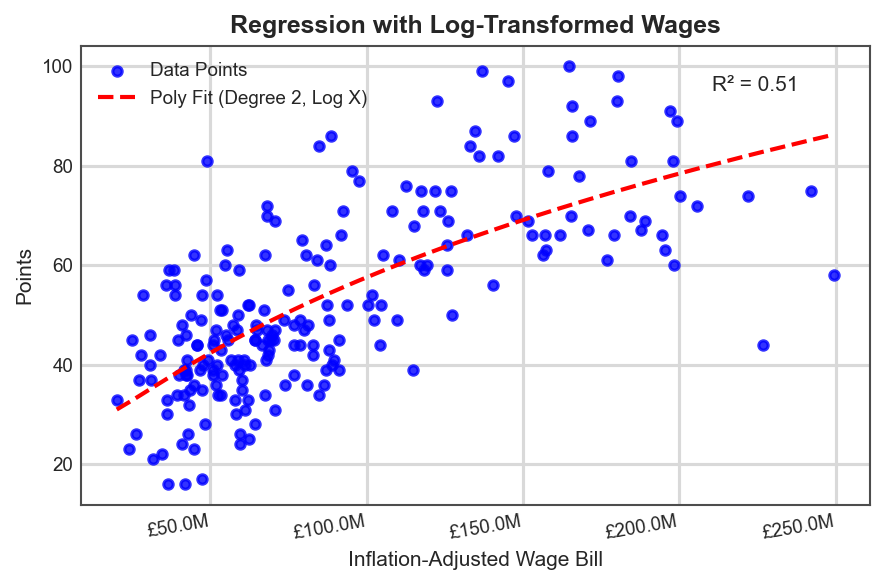
In analyzing the relationship between wages and points accumulation, I applied two polynomial-fitted regression models to log-transformed wages. The log transformation was necessary to address normality concerns and better capture the underlying trends in the data. A simple linear regression, in this case, would struggle to accurately represent the patterns observed, particularly given the apparent non-linearity in wage-to-points relationships. The Premier League chart, for instance, reveals a diminishing return on points accumulation as wage expenditure increases. This suggests that while increased spending on wages does contribute to performance, its impact plateaus at higher levels, making it a key consideration for stakeholders evaluating the efficiency of financial investments in squad salaries.
Championship
The Championship, however, presents a more ambiguous picture. Unlike the Premier League, where a clearer diminishing returns pattern emerges, the Championship’s wage-to-points relationship appears far weaker. Even with log-transformed wages and a non-linear regression fit, the correlation remains faint. This may be due to the tighter financial constraints within the league, where most clubs operate within a wage expenditure range of approximately £10 million to £60 million. Within this confined range, wage spending alone does not strongly dictate season outcomes. That being said, it would be naive to assume that dramatically exceeding this range pushing wage expenditure beyond £100 million would not have a direct impact on points accumulation. However, within the existing financial landscape of the Championship, wage spending appears to have only a weak influence on performance, highlighting the importance of other factors such as Player Quality, Squad Depth, tactical efficiency, squad cohesion, and managerial quality.
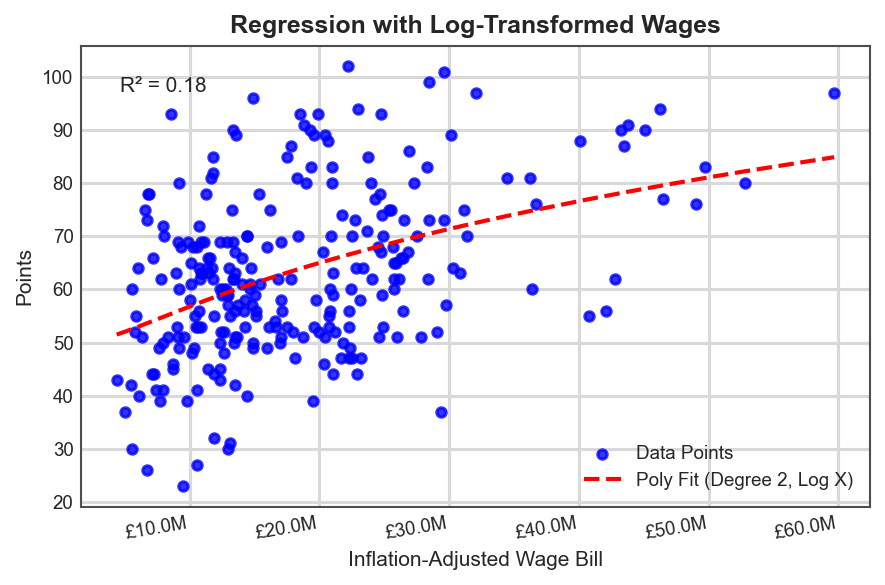
Data Transformations
A common challenge when working with financial data particularly wage bills, which often vary by orders of magnitude is that the raw values tend to be skewed, with a long tail of very high observations. By applying a logarithmic transformation, we “compress” the scale of these larger values, bringing them closer in line with the rest of the data.
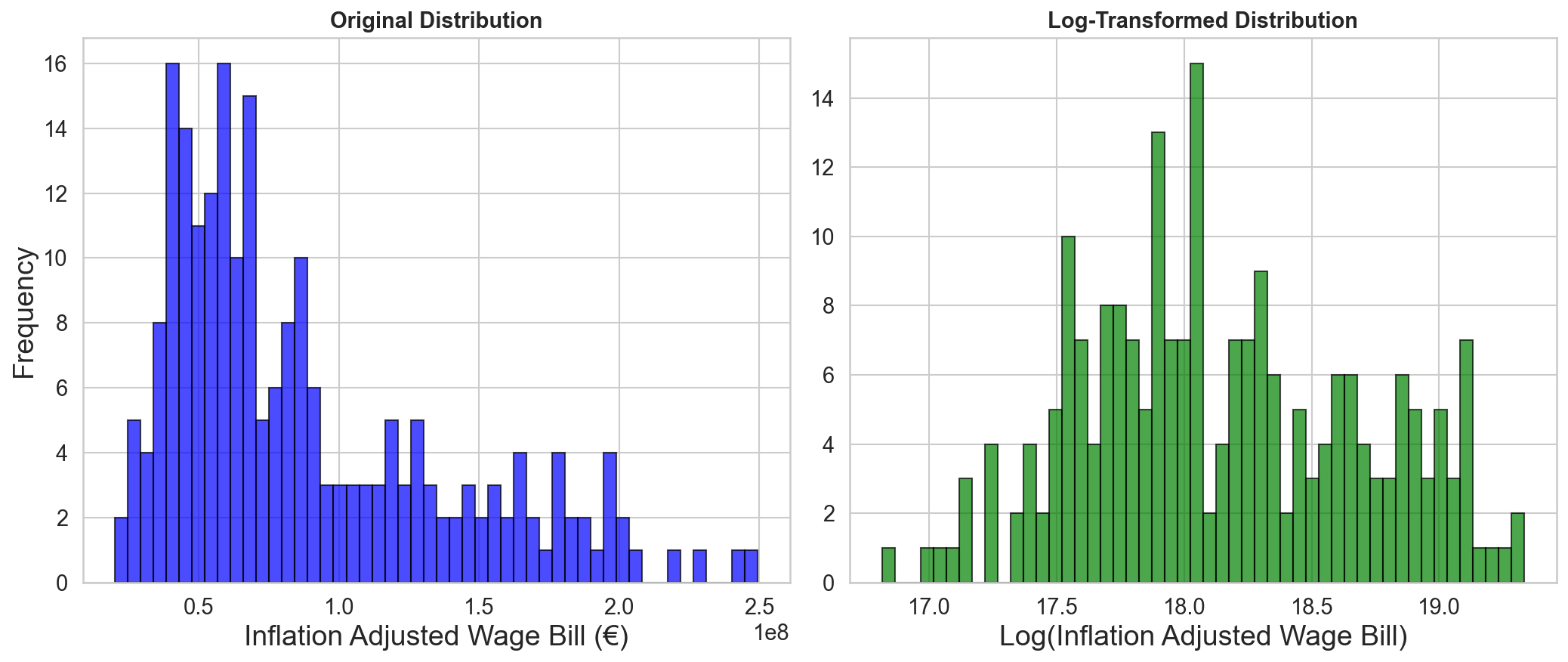
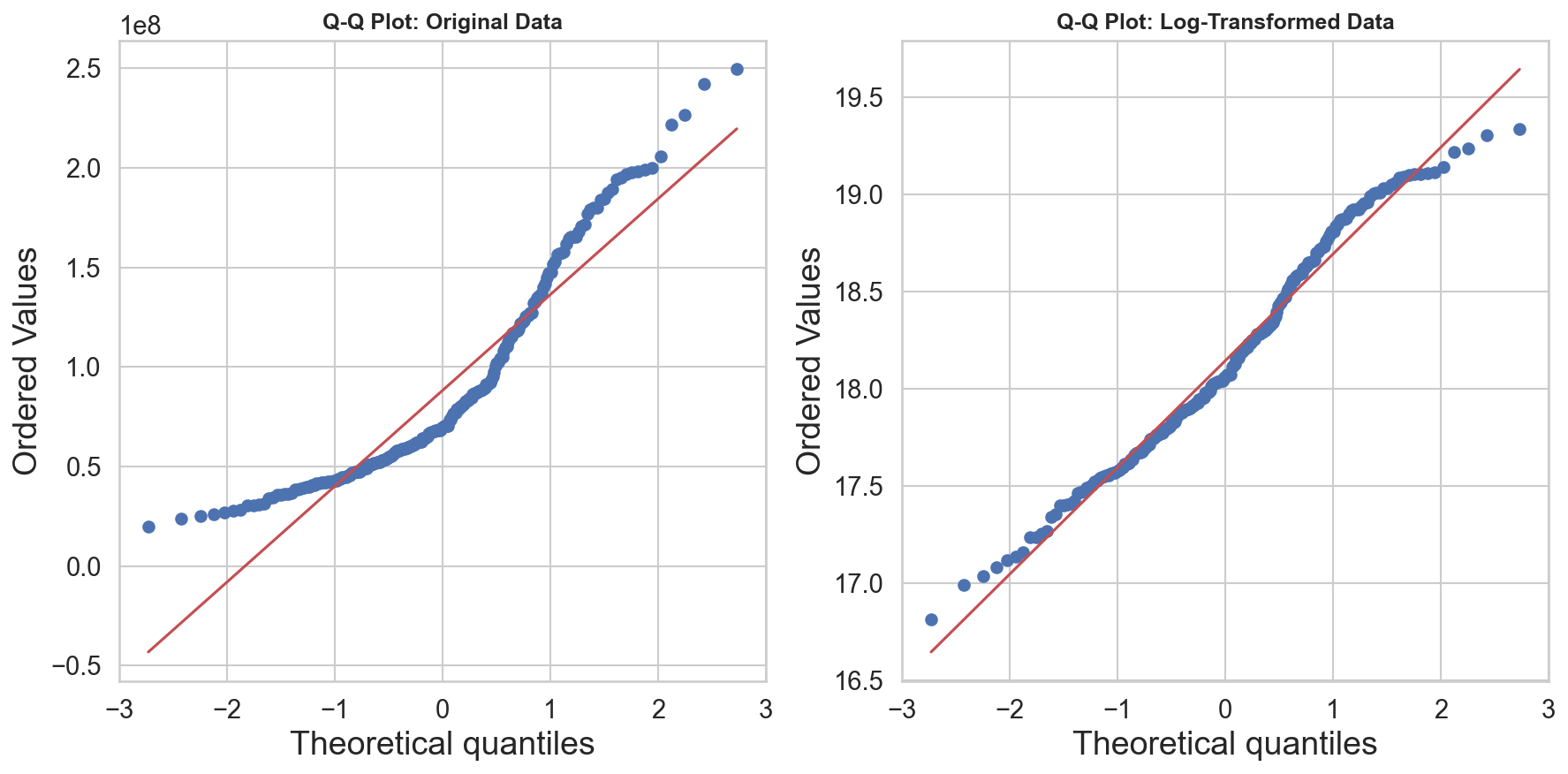
Concretely, there were two main reasons for log-transforming the wage bill data:
- Reducing Skewness
The raw wage data showed a right-skewed distribution, meaning a small number of extremely high wage bills pulled the mean upward. Log-transforming helps mitigate the effect of such extreme values, making the overall distribution more symmetric and reducing the influence of outliers. - Meeting Statistical Assumptions
Many statistical techniques assume the data follows (or at least approximates) a normal distribution. To check whether the log transformation was effective, we compared histograms and used Q–Q plots before and after the transformation
In exploring the wage–points relationship, we tested multiple candidate models detailed above and subjected each to diagnostic checks such as residual plots, Q–Q plots, and cross-validation. Linear regression initially provided a simple baseline, but it often struggled to capture the diminishing returns that emerge with higher wage spending. By contrast, a small polynomial model effectively illustrated how incremental boosts in wages eventually yield progressively smaller performance gains. This combined approach methodical testing of multiple models, supported by robust diagnostics ultimately highlighted the model that best explains the wage–points dynamic while still offering practical, data-driven insights for club decision-makers
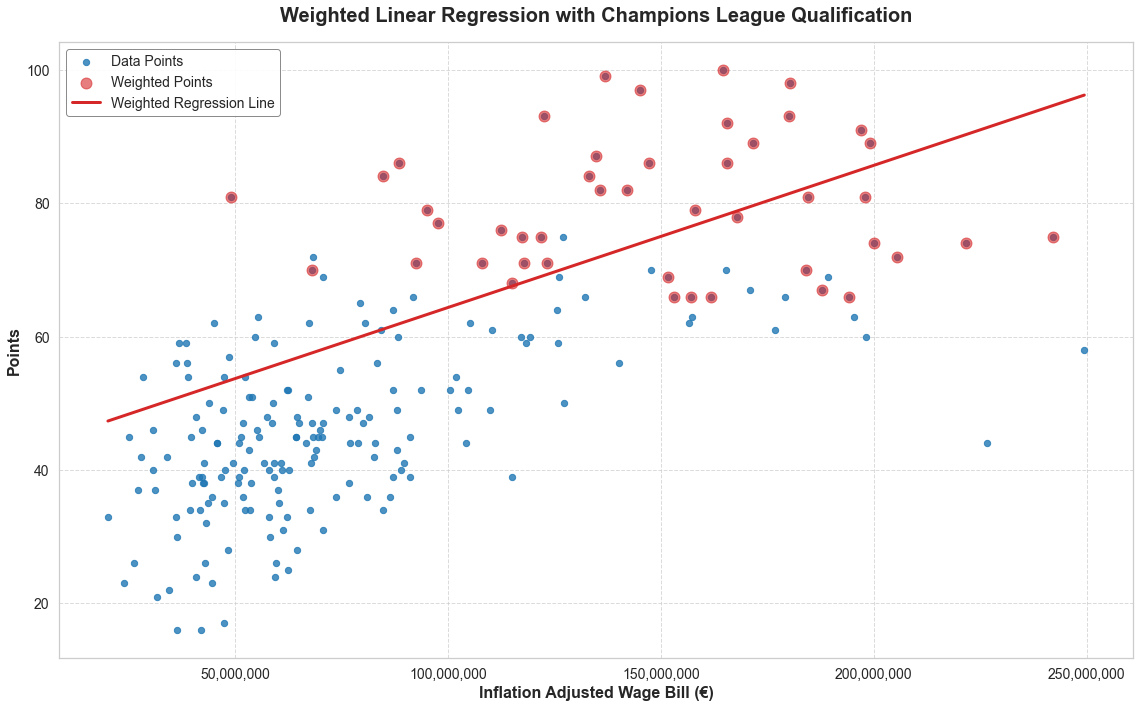
Exploring Other Models: In addition to the log-normal polynomial approach, we experimented with several alternative methods including standard linear regression, polynomial fits of varying degrees, local regression (LOESS), European Competition Weighted Regression and spline regression. Each method offers unique advantages; for instance, linear regression provides an easily interpretable measure of correlation, while spline fits can capture more nuanced, nonlinear patterns. However, these more flexible techniques may be prone to overfitting if not carefully managed. Ultimately, examining multiple approaches allowed us to confirm that our chosen model accurately reflected the wage–points relationship without unnecessary complexity. Readers interested in the technical details of these other approaches can contact us for more information. See example above
Predictions from Season (2023-2024)
Premier League
For the 2023-2024 season, we applied the polynomial regression fit to estimate the expected points for each club based on their wage expenditure in both the Premier League and the Championship. By comparing these predicted points to the actual points accumulated, we were able to assess which teams overperformed or underperformed relative to their wage spending. Naturally, no model is a perfect fit, but the Premier League demonstrates a stronger correlation between wages and performance, making the model's insights perhaps more 'reliable'. The Championship, on the other hand, exhibits greater variability, with a weaker correlation and a larger margin of error in its predictions. Despite these limitations, this model serves as a useful benchmark a crude but effective reference point. Clubs can use it to evaluate their wage expenditure against predicted performance, offering a simple way to gauge whether they are achieving a reasonable return on investment.
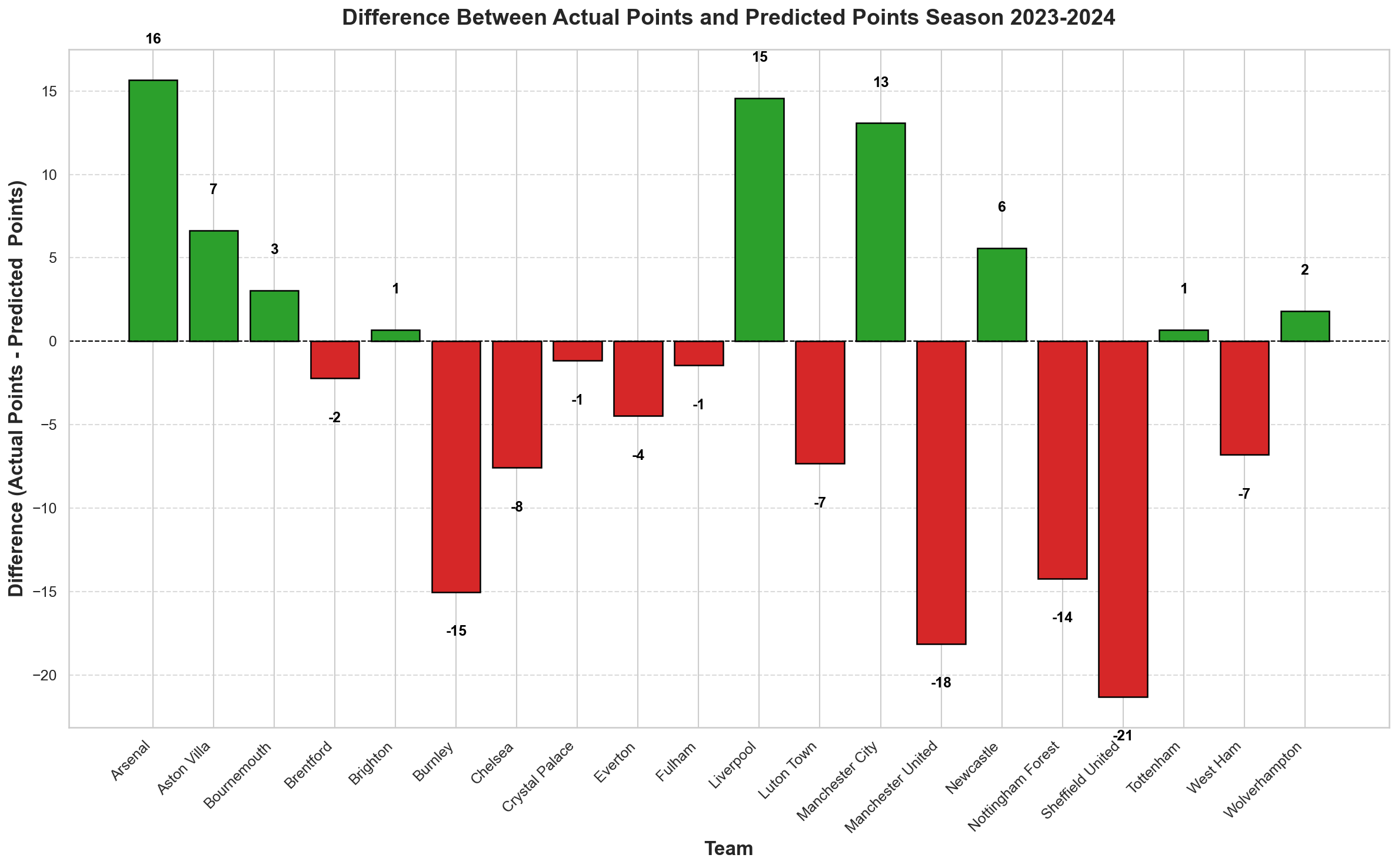
This bar chart depicts how each Premier League club’s actual points tally compares to the points predicted by the polynomial wage–points model, highlighting overperformance (green bars) or underperformance (red bars). Clubs shown with positive values have outperformed the model’s expectations. Conversely, negative values indicate clubs that have underperformed relative to their estimated outcomes.
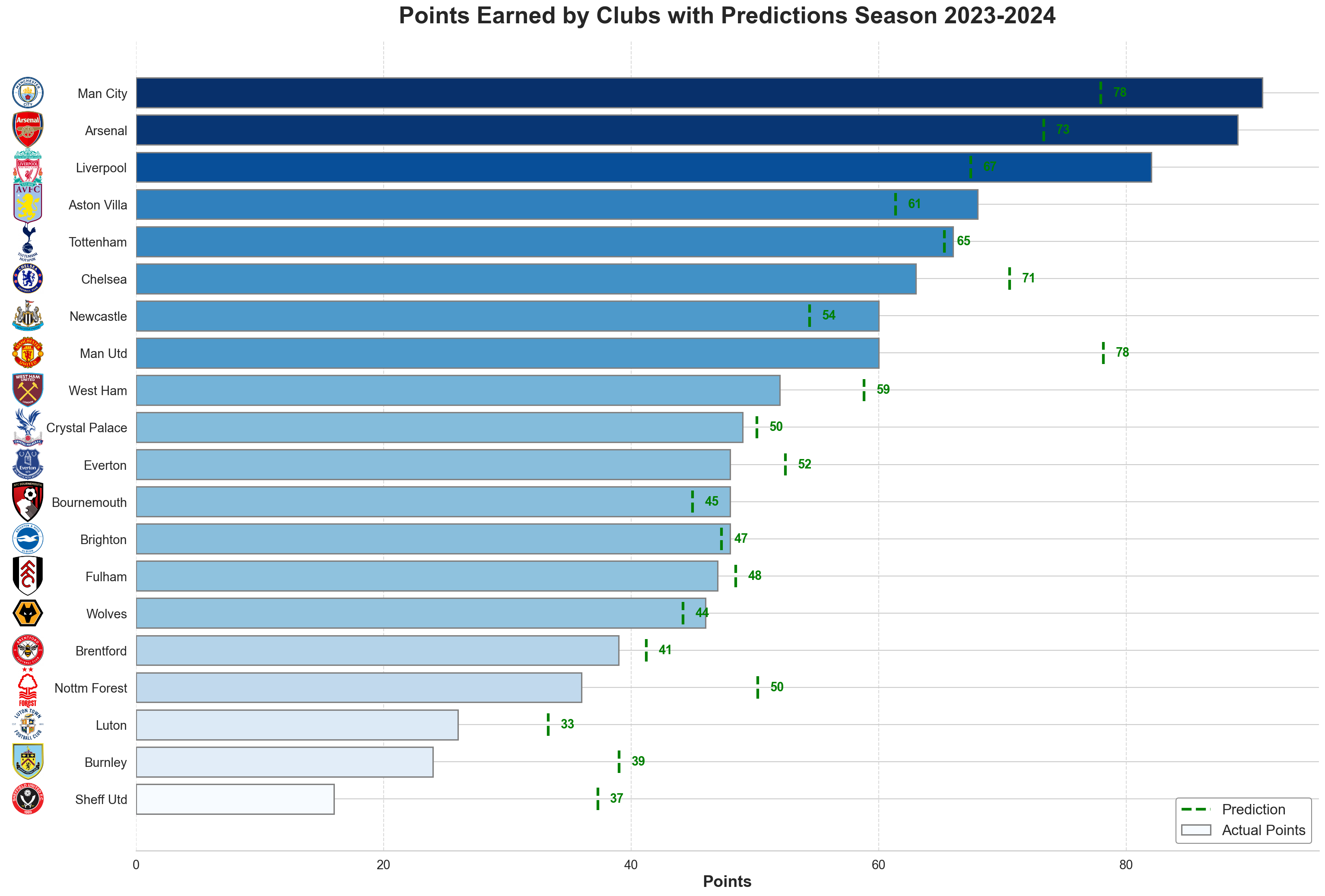
Championship
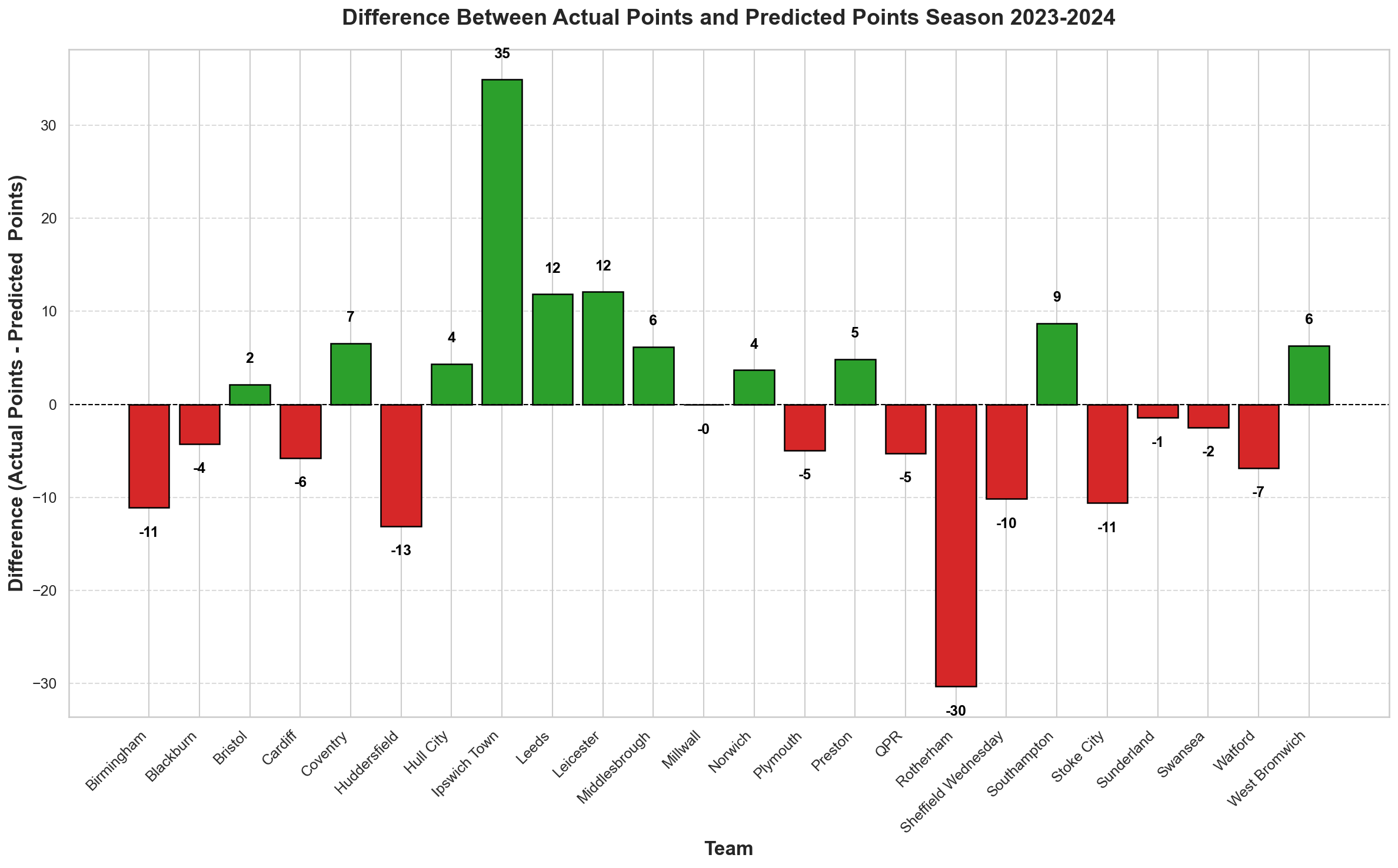
Most clubs in the Championship fall relatively close to the baseline expectation, with only a few notable outliers such as Ipswich Town and Rotherham. Ipswich significantly overperformed relative to their wage bill, while Rotherham underperformed, suggesting that the latter’s wage expenditure may not be yielding the expected returns.
Of course, numerous external factors influence these deviations such as injuries, tactical setups, managerial decisions, and squad depth all play significant roles. While these elements are beyond the scope of this analysis, the wage-to-points comparison provides a starting point for stakeholders to investigate further. In Rotherham’s case, for example, their wage bill might prompt deeper questions about inefficiencies in squad management or recruitment. Ultimately, while this approach is not a definitive measure of success, it offers a valuable lens through which clubs can assess their financial efficiency in relation to performance.
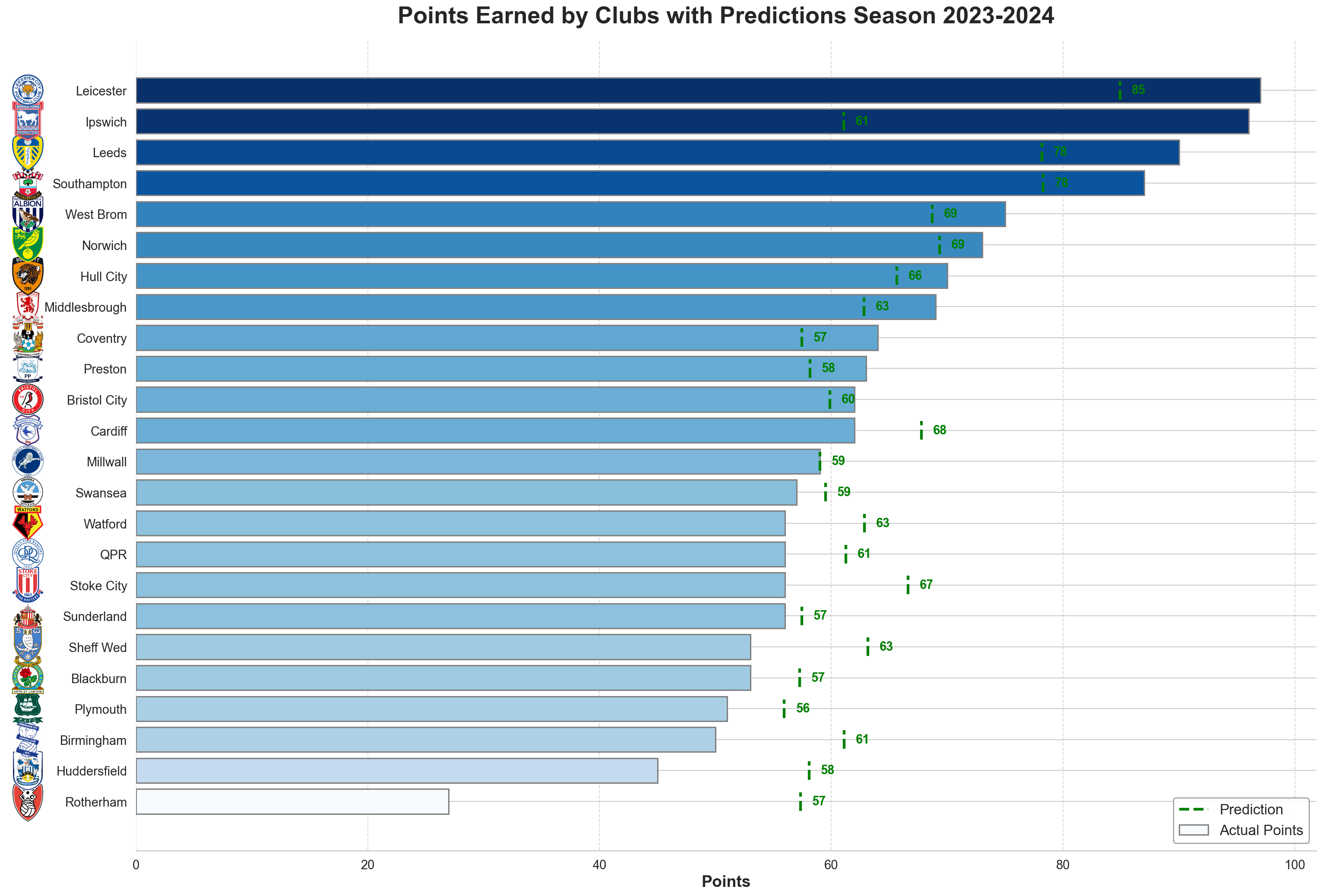
Season 2024-2025 Over and Under Performances
Premier League
Applying the same polynomial regression approach to the ongoing 2024-2025 season, we can now analyze wage expenditure relative to expected and actual points. With the majority of the season completed in both the Premier League and the Championship, league positions are beginning to solidify. The variability in potential finishing positions is narrowing, making this an opportune time to evaluate teams’ performances in relation to their wage bills. By estimating expected points based on wages and comparing them to actual standings, we can once again assess which teams are exceeding expectations and which are falling short.
In the Premier League, notable outliers emerge. Bournemouth and, of course, Liverpool projected to be champions have significantly overperformed relative to their wage expenditure, demonstrating remarkable efficiency in converting financial resources into results. On the other hand, several high-spending clubs, including Manchester United, Manchester City and even Southampton and Leicester, have underperformed based on their wage bills. While Manchester City remains in contention for a Champions League spot, they have not lived up to the performance levels suggested by their financial outlay and will fall short of a title challenge. This highlights the broader theme that, while wages are a strong predictor of success, they are not an absolute determinant
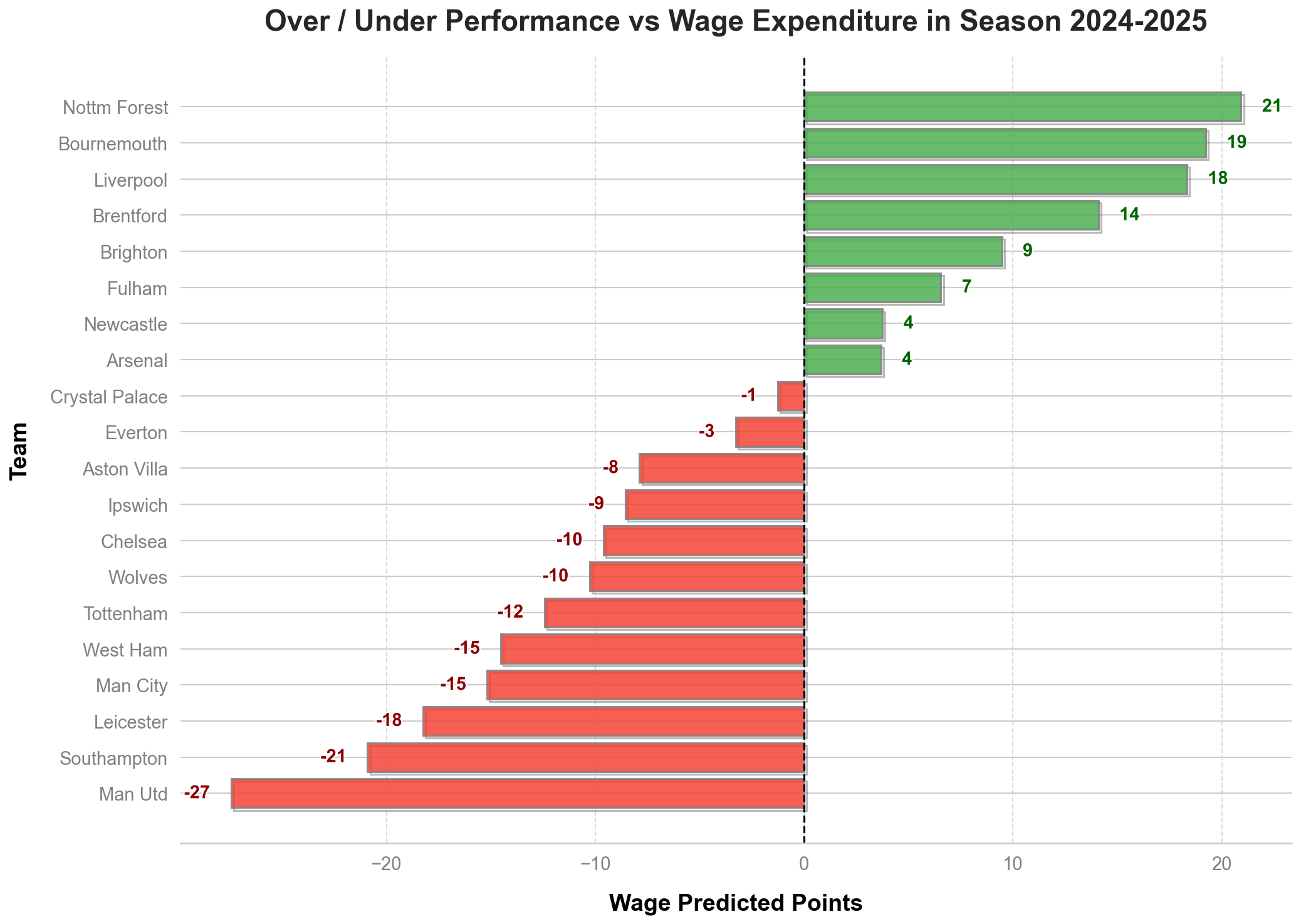
Championship
The Championship follows a similar trend in terms of approach, with some significant over- and underperformers. Sheffield United stands out as a team defying expectations, as they were not widely predicted to be in the promotion playoff spots at the start of the season, yet they find themselves in strong contention. On the flip side, Luton recently relegated from the Premier League has struggled to reassert itself, while Derby County finds itself in a shock relegation battle despite pre-season odds of 12-1 for a playoff finish. These cases reinforce the value of using wage expenditure as a benchmarking tool, even if not an absolute measure of success. For stakeholders, this analysis serves as a useful conversation starter, providing a structured way to assess whether a club’s financial outlay is delivering the expected return in terms of league position and points accumulation.
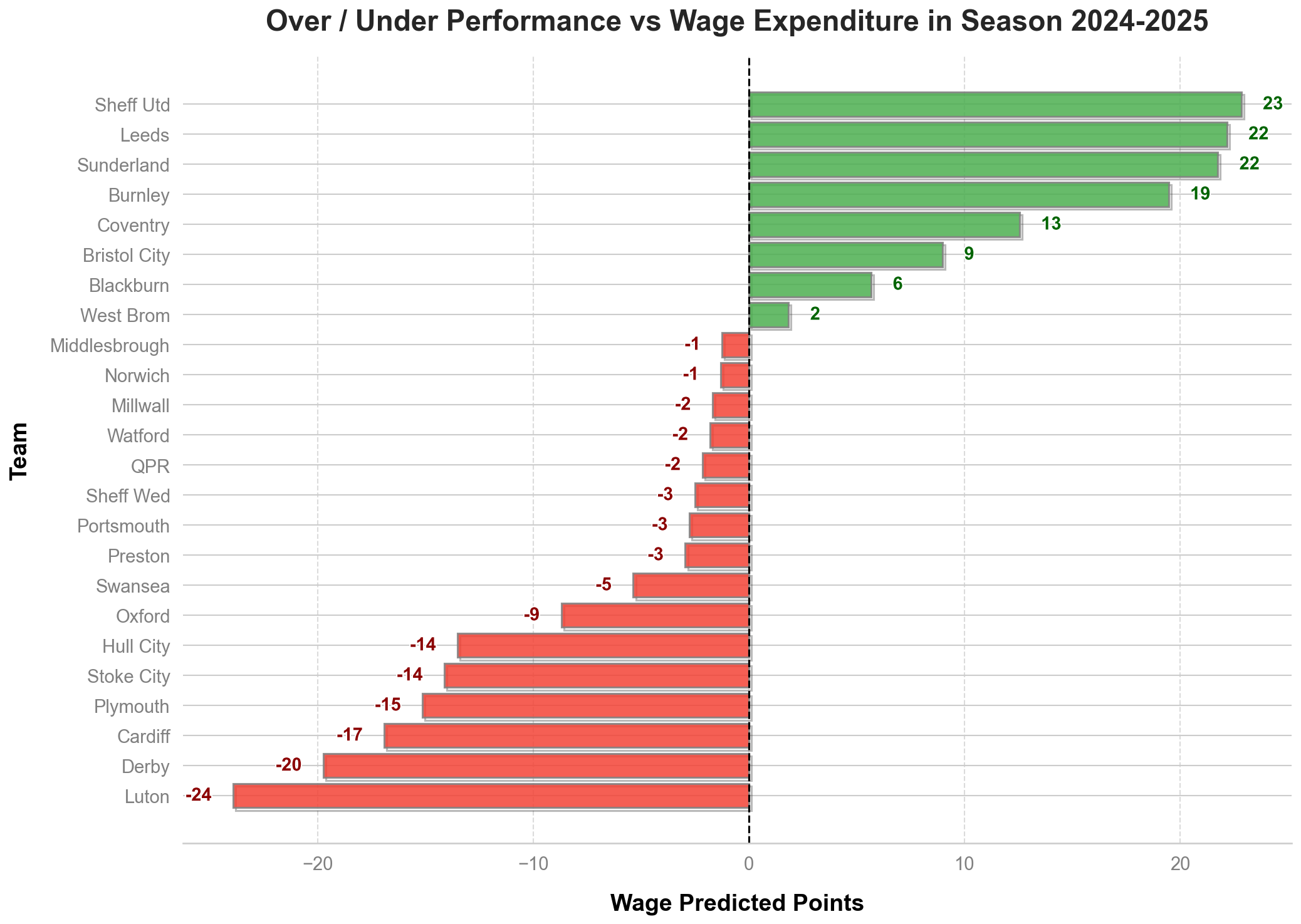
The Pareto Principle: Top 10 Highest Paid Players
The hypothesis underlying this analysis from this point on is anchored in the Pareto Principle, which suggests that approximately 80% of results typically come from 20% of causes. In the context of Premier League football, this translates to the expectation that a club’s performance is disproportionately influenced by a select group of high-earning, key players. Given a standard squad size of around 25 to 30 players, clubs allocate wages based on historical performance metrics, market constraints, and budgetary limitations, inevitably resulting in certain players receiving significantly higher wages. Under this framework, the core assumption is that if a club maximizes the minutes played by its ten highest-paid players, those who presumably deliver superior on-field value, then the overall team performance should markedly improve. Essentially, the investment in these top earners, if leveraged effectively through increased playing time, should yield stronger competitive outcomes, directly reflecting the principle that a small subset of players can disproportionately drive team success.
Leveraging the Pareto Principle for squad-building hinges on recognizing that a small cohort of top earners can disproportionately influence match outcomes. However, real-world complications abound. If one or two key players among these top earners sustain long-term injuries or if managerial change shifts tactics unfavourably for them clubs may struggle to realize their expected performance gains. Historical precedents, such as Leicester City’s improbable 2015–16 Premier League title, also demonstrate that collective synergy among mid-range earners can exceed the impact of one or two marquee players on large wages, even though retrospectively those players may have been underpaid in contrast to their careers since. Hence, while the data hint that maximizing minutes for high earners usually correlates with improved results, it cannot replace a holistic squad-building ethos that fosters overall balance, fitness, and motivation.
Motivating Example
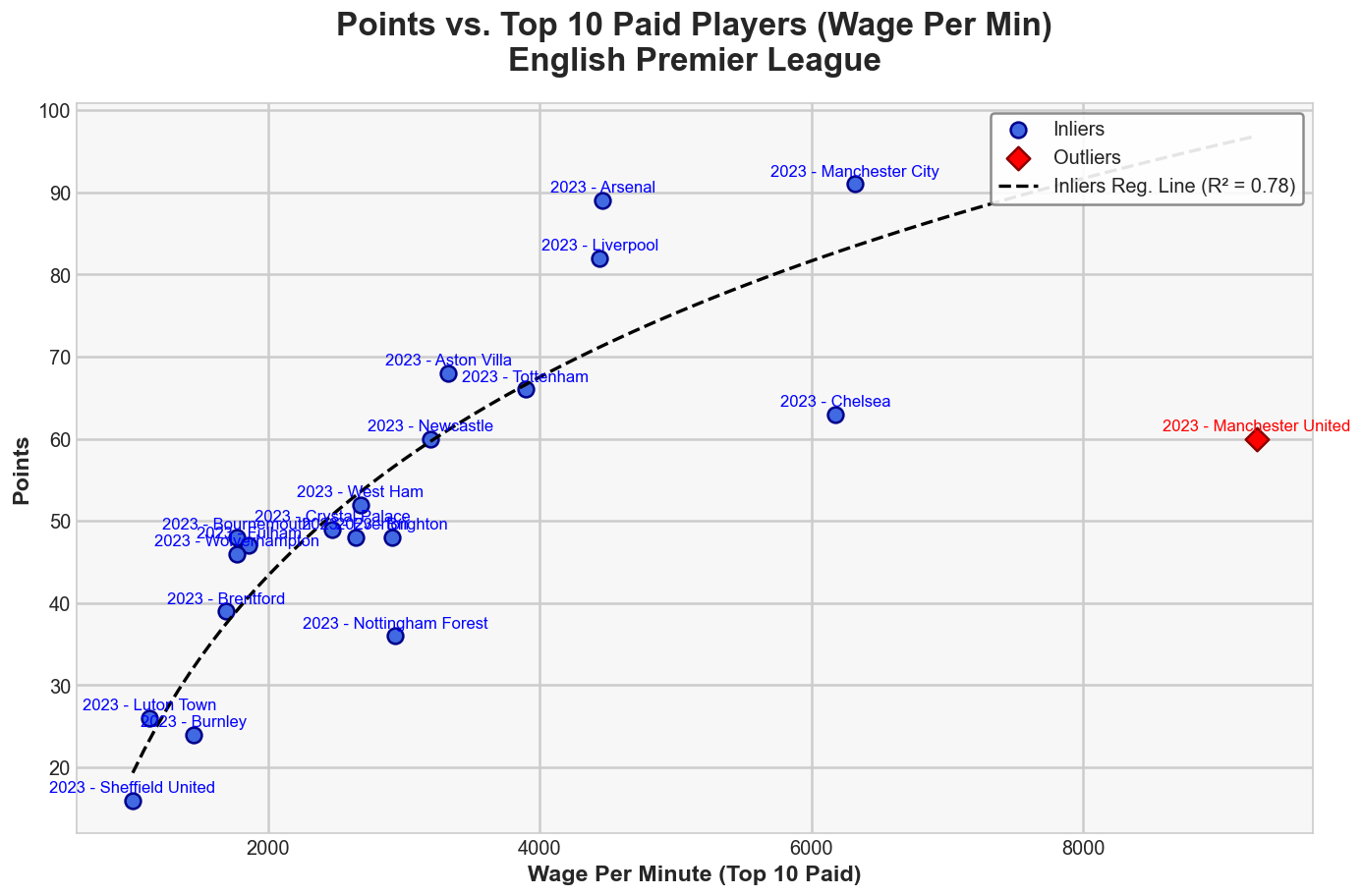
Building on our hypothesis using the Pareto Principle, we examined the relationship between playing time and wages for the top 10 highest-paid players in each squad. The underlying assumption here is that the best-paid players are also the best performers, meaning that maximizing their playing time should, in theory, enhance a team’s capacity to accumulate points. Essentially, if a team’s highest earners are consistently on the pitch, their contribution should translate into better overall performance. This concept forms the foundation of our analysis, which seeks to determine whether teams are efficiently allocating playing time to their most valuable assets.
Looking at a practical example from the 2023-2024 Premier League season, we found a strong linear relationship between points and wage per minute a metric derived by dividing the total wages of a team’s top 10 highest-paid players by their total minutes played throughout the season. This simple measure offers a proxy for how effectively clubs are utilizing their financial resources in relation to game time. When plotted, this relationship produced an R-squared value of 0.78, indicating a strong correlation between points accumulation and the amount of playing time given to the top-paid players. However, one notable outlier in this analysis was Manchester United, a club that, despite significant wage investment, did not translate financial spending into on-field success. This aligns with broader trends seen in recent years, where Manchester United’s wage structure and performance have often been disconnected an issue that warrants deeper exploration in a separate analysis.
Despite this outlier, the broader findings suggest that this approach has merit. The motivating example reinforces the idea that clubs should closely monitor the playing time of their highest-paid players as a potential key driver of success. By applying the Pareto Principle, teams can assess whether they are getting sufficient "bang for their buck" from their wage expenditures. If a club can ensure that its top earners are on the pitch as much as possible assuming they maintain fitness and form it should theoretically maximize its points accumulation potential. This method provides a structured way for clubs to evaluate wage efficiency and optimize squad management decisions in pursuit of better performance.
Premier League
By analyzing the wage per minute of the top 10 highest-paid players and their corresponding points accumulation, particularly in the Premier League across the last 10 Seasons, we observe a reasonably strong linear relationship. The regression model highlights clear outliers, pinpointed in red, such as Manchester United and Chelsea in 2022, where performance did not align with wage expectations. These cases naturally invite further discussion narratives can be constructed around their extreme inefficiencies. However, for the majority of clubs, the relationship between wage expenditure and points remains well-structured, reinforcing the predictive power of financial investment in squad strength.
This approach offers an effective, data-driven tool for stakeholders a one-stop overview to assess the expected return on investment in a club’s top 10 highest-paid players. Given that these players often represent the most substantial financial commitment in a club’s wage structure, understanding their impact on performance is essential for decision-making in recruitment, squad management, and financial planning.
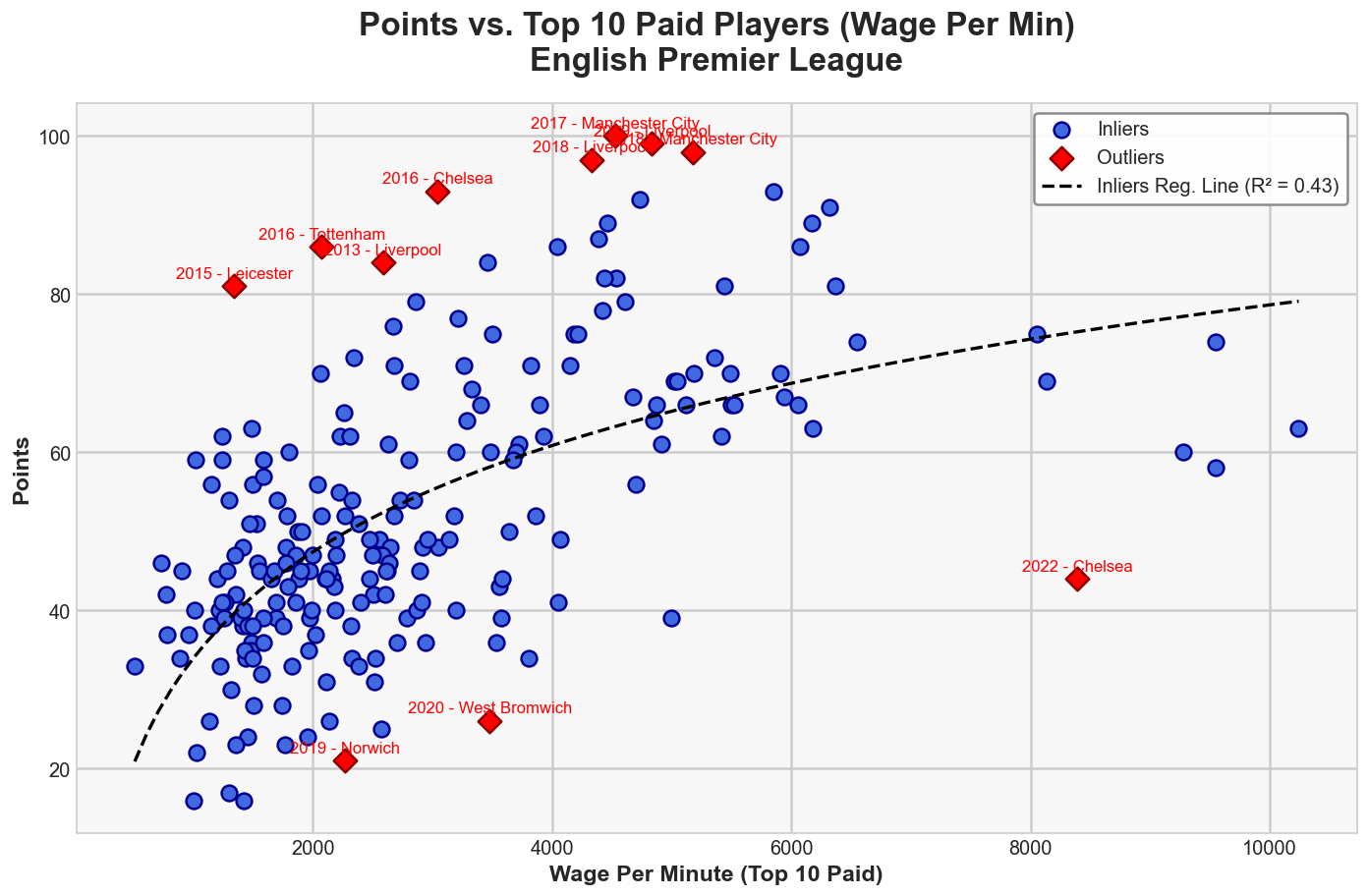
The marginal effect of wage per minute on points is relatively small but measurable. Starting with an initial wage per minute of 5000, the model predicts an expected points total of 65.94. With each 1% increase in wage, the predicted points rise incrementally based on the linear relationship. For example, at a 10% increase in wage (5500 per minute), the model predicts 69.31 points, reflecting a steady but modest increase. The relationship remains linear, meaning that each additional percentage increase in wage contributes the same absolute increase in points (approximately 0.34 points per 1% wage increase). However, unlike the log-log model, where percentage changes have a fixed proportional effect, the impact here remains constant in absolute terms but varies in percentage terms depending on the wage level. At a 20% increase in wage (6000 per minute), the predicted points reach 72.69, illustrating how higher spending on wages correlates with improved performance, albeit with no guarantee as there is evidence of diminishing returns.
Championship
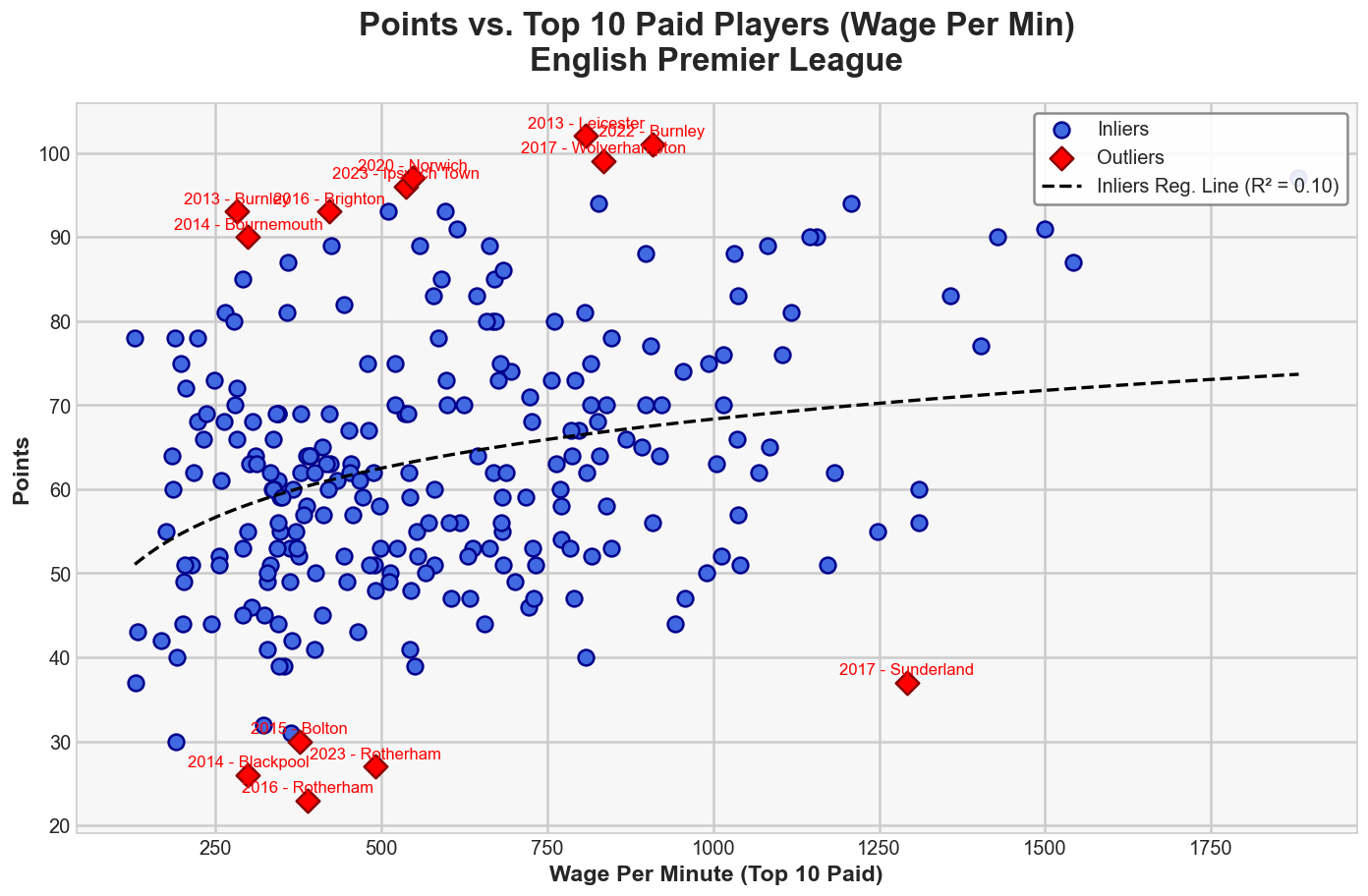
When analyzing the Championship, the linear regression relationship between wage per minute and points accumulation is significantly weaker compared to the Premier League. While there is still a positive relationship meaning that an increase in wage per minute for the top 10 highest-paid players does, in theory, lead to higher points it is a much weaker effect. This suggests that many other factors influence success in the Championship beyond just wage expenditure. Unlike the Premier League, where financial power is a stronger predictor of performance, the Championship presents greater variance in points accumulation, indicating a more complex competitive landscape.
The marginal effect of increasing wage per minute on points is notably weaker compared to the Premier League. The R² value of 0.1 indicates that wage expenditure explains only a small portion of the variance in points accumulation. The slope of 0.017 suggests that a 1% increase in wage leads to only a 0.017% increase in points a very modest return on investment
Starting with an initial wage per minute of 500, the model predicts an expected points total of 62.19. Since the relationship remains linear, each 1% increase in wage per minute results in a fixed absolute increase in points, although the effect is relatively minor compared to the Premier League.
For example:
- A 10% increase in wage per minute (550 per minute) results in a predicted points total of 62.93, a small but steady rise.
- At a 20% increase (600 per minute), the model predicts 63.62 points, further reinforcing the marginal impact of wage growth on success.
- A 50% increase in wage (750 per minute) only raises expected points to 65.42, demonstrating the diminishing return on investment at higher wage levels.
- Even at a 100% increase in wages (1000 per minute), the model predicts only 67.82 points, showing that simply increasing wages is not a guaranteed path to dominance.
Disclaimer
This article does not claim that wage bill is the sole determinant of success especially in a league like the Championship, where financial structures are less extreme and more compressed. Several key dynamics help explain why wage expenditure has less predictive power in this division:
- Closer wage distribution: Most Championship clubs operate within a relatively narrow wage range, reducing the financial gap between teams.
- Parachute payments: Relegated teams receive financial support from the Premier League, creating temporary financial disparities that do not always translate into immediate on-field dominance.
- Fixture congestion & squad depth: The 46-game season, coupled with additional cup competitions, increases the physical and tactical demands on squads, making factors like squad rotation, injuries, and managerial approach more impactful than in a shorter, more financially stratified league like the Premier League.
Despite these complexities, analyzing wage expenditure still provides a useful benchmarking tool. While not a determinant of success, it remains a yardstick for financial health and sustainability, helping clubs manage their budgets without overspending or underspending. Furthermore, by examining the marginal effects assessing the return on investment for each additional increment in wage expenditure clubs can still extract valuable insights into how efficiently their wage bill translates into on-field performance.
Multi-Level Modelling: Mixed Effect Linear Model
Given the natural correlation of club wages and performance from one season to the next, a mixed-effects model was implemented to handle data with nested and repeated measures.
Mixed linear models allow us to handle data with nested or repeated measurements in this case, multiple observations of Premier League teams across different seasons. By including a random intercept for each team, we capture each team’s baseline tendency to earn points that isn’t explained solely by wages, minutes, or season effects. Using Season as a categorical predictor controls for league-wide differences between seasons, while the log transformation of points helps normalize the distribution and interpret the effects 'WagePerMins' and 'Mins Played' on a multiplicative scale. Overall, this approach yields more nuanced estimates of how wages and playing time relate to performance, while accounting for inherent team-level and season variation.
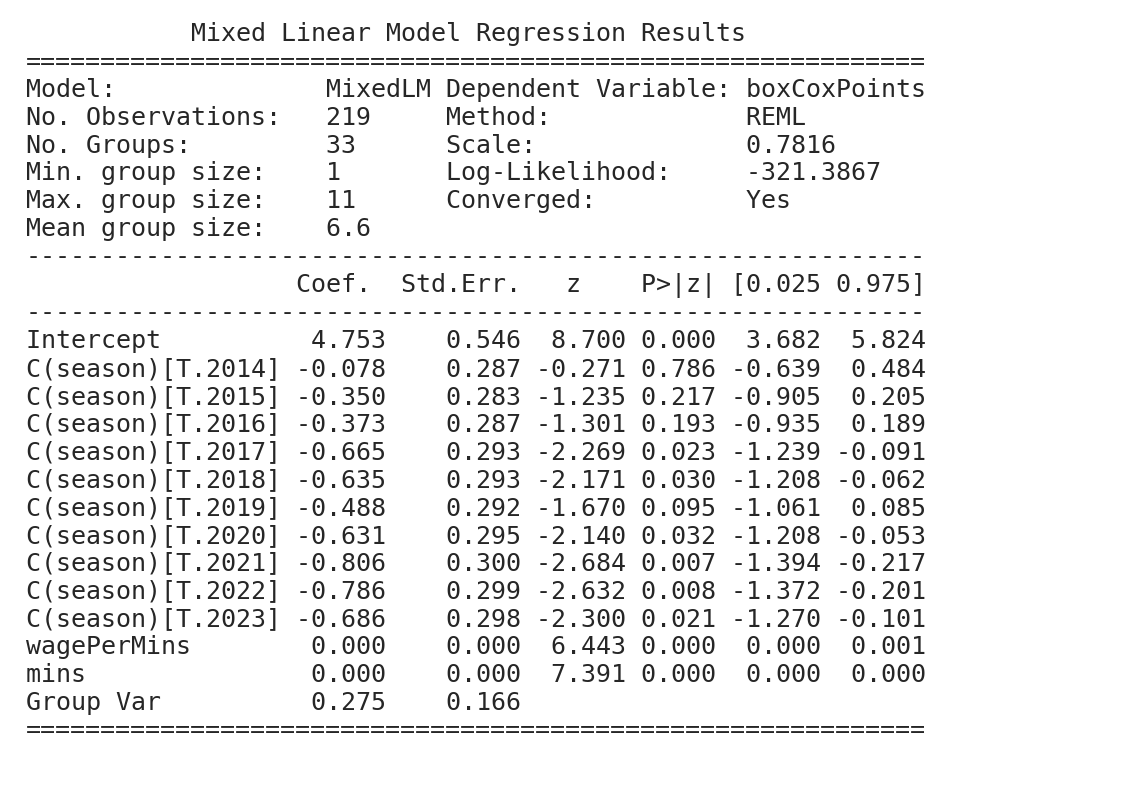
The table reports a mixed-effects model in which the response variable, Points (Box-Cox Transformed). By allowing each team its own random intercept, the model accounts for variations in baseline performance across teams. The positive and highly significant coefficients for wagePerMins and mins indicate that both higher wages (per minute) and more playing time tend to boost a team’s transformed points. Most of the estimated coefficients for season are negative, suggesting that, compared to the reference season (2013), teams in certain later seasons averaged lower (Box-Cox–transformed) points. Lastly, the relatively small random-effect variance (Group Var) shows that the team-level differences, while present, are not overwhelmingly large once wages, minutes, and seasons are taken into account.
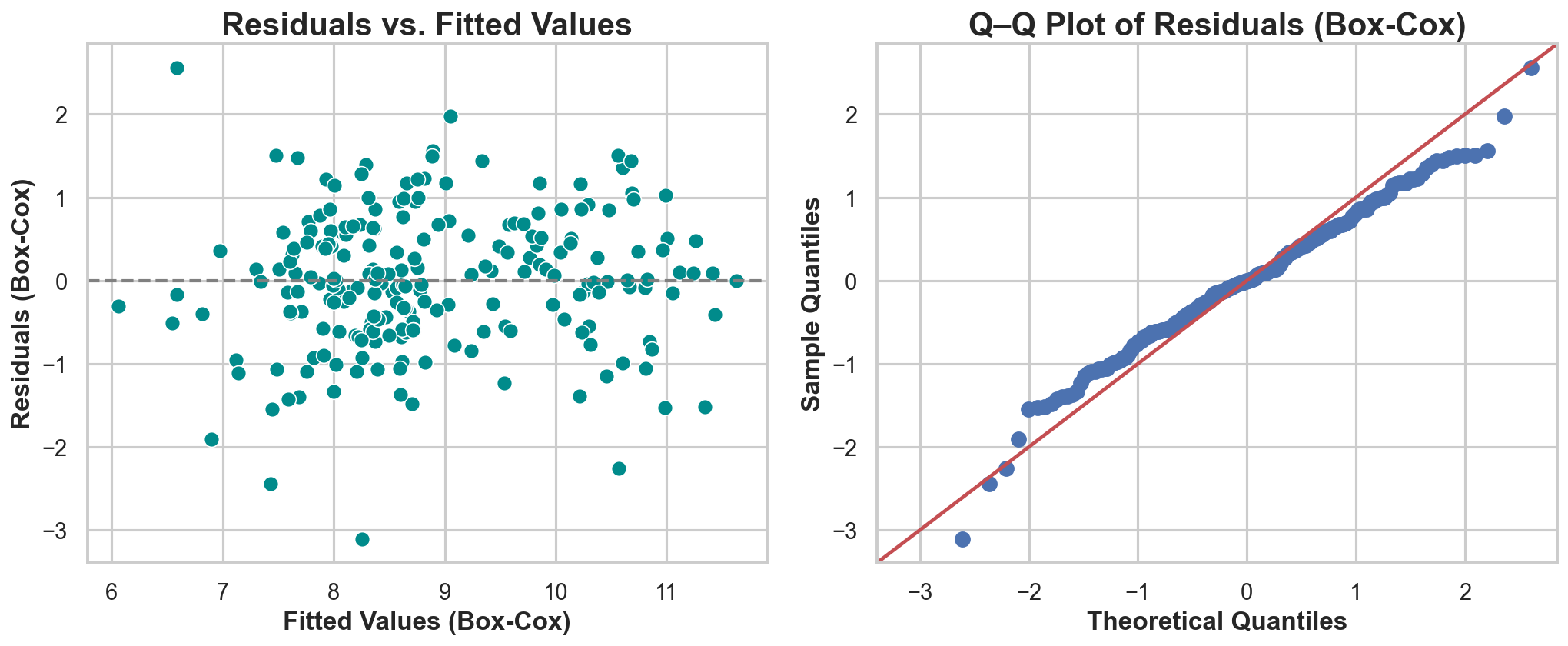
These two plots assess how well the model’s assumptions hold after the Box-Cox transformation. In the Residuals vs. Fitted Values (left) plot, the residuals appear fairly evenly scattered around zero, with no obvious curvature or strong patterns, suggesting that the linear relationship and constant variance assumptions are reasonably satisfied. In the Q–Q Plot (right), most data points follow the diagonal line, indicating the residuals are close to normally distributed; only the tails show some mild deviation. Together, these diagnostics support the suitability of the Box-Cox–transformed model, though they also hint that a small portion of the data may depart from strict normality at the extremes.
Interpreting the Model
Although the coefficients (0.00046 for wage per minute and 0.00018 for minutes played) appear very small due to the scaling involved, they accumulate to meaningful differences when considering realistic intervals such as increases of thousands in wage units or total minutes played. This perspective clarifies their practical significance." For instance, an increase of 1 unit in wage per minute (e.g., from 4000 to 4001) is associated with an increase of about 0.00046 in the Box-Cox scale. Because wage values are typically in the thousands, a more realistic scenario is to look at a larger interval; a 1000-unit increase would yield about a 0.46 change on the transformed scale which can convert into a more noticeable difference in the actual points once the inverse Box-Cox transformation is applied.
Similarly, the 0.00018 coefficient for minutes played indicates that every additional minute has a minuscule impact on the predicted Box-Cox value. However, when accumulated over a season’s worth of minutes, even such small per-minute increments can translate into significant differences in the final points. When we approach these coefficients, we pay careful attention to the units: because they originate from a model that used both standardization (to ensure comparability among predictors) and a Box-Cox transformation (to correct for skewness and stabilize variance), their raw magnitude is less about ‘smallness’ and more about reflecting the inherent scale of the data. By examining predictions over realistic intervals say, comparing predictions at 4000 versus 5000 wage per minute we can appreciate how these seemingly tiny effects add up to yield meaningful changes in expected points after back-transforming to the original scale.
Example Explained
For readers interested in the technical details, here’s exactly how our model predictions are calculated. If you prefer just the results, feel free to skip to the next section.
- Compute the Linear Predictor on the Box-Cox Scale
- Formula:
LP = Intercept + (beta_wage × wage) + (beta_mins × minutes) - Given values:
- Intercept = 4.75324
- beta_wage = 0.00045917
- beta_mins = 0.00018072
- wage = 5000
- minutes = 14000
- Intercept = 4.75324
- Calculation:
- Wage Component = 0.00045917 × 5000 = 2.29586
- Minutes Component = 0.00018072 × 14000 = 2.53008
- Linear Predictor (LP) = 4.75324 + 2.29586 + 2.53008 = about 9.57918
- Wage Component = 0.00045917 × 5000 = 2.29586
- Apply the Inverse Box-Cox Transformation
The inverse Box-Cox function (for lambda ≠ 0) is:
Points = exp[(ln(lambda × LP + 1)) / lambda] - Given lambda: 0.3677
Steps
- Multiply LP by lambda and add 1:
(0.3677 × 9.57918) + 1 ≈ 3.52392 + 1 = 4.52392 - Take the natural logarithm:
ln(4.52392) ≈ 1.510 - Divide by lambda:
1.510 / 0.3677 ≈ 4.106 - Exponentiate the result:
exp(4.106) ≈ 60.6 - Final Result
Predicted points: Approximately 60.6 points for a team with a wage per minute of 5000 and 14,000 minutes played.
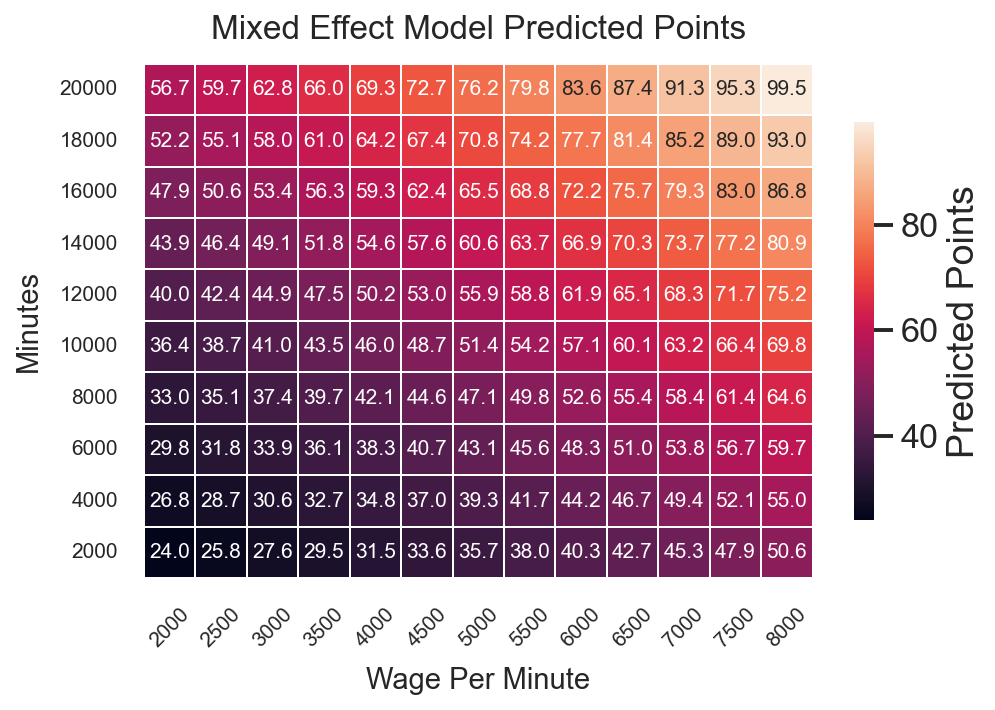
Mixed Effect Model: Random Intercept
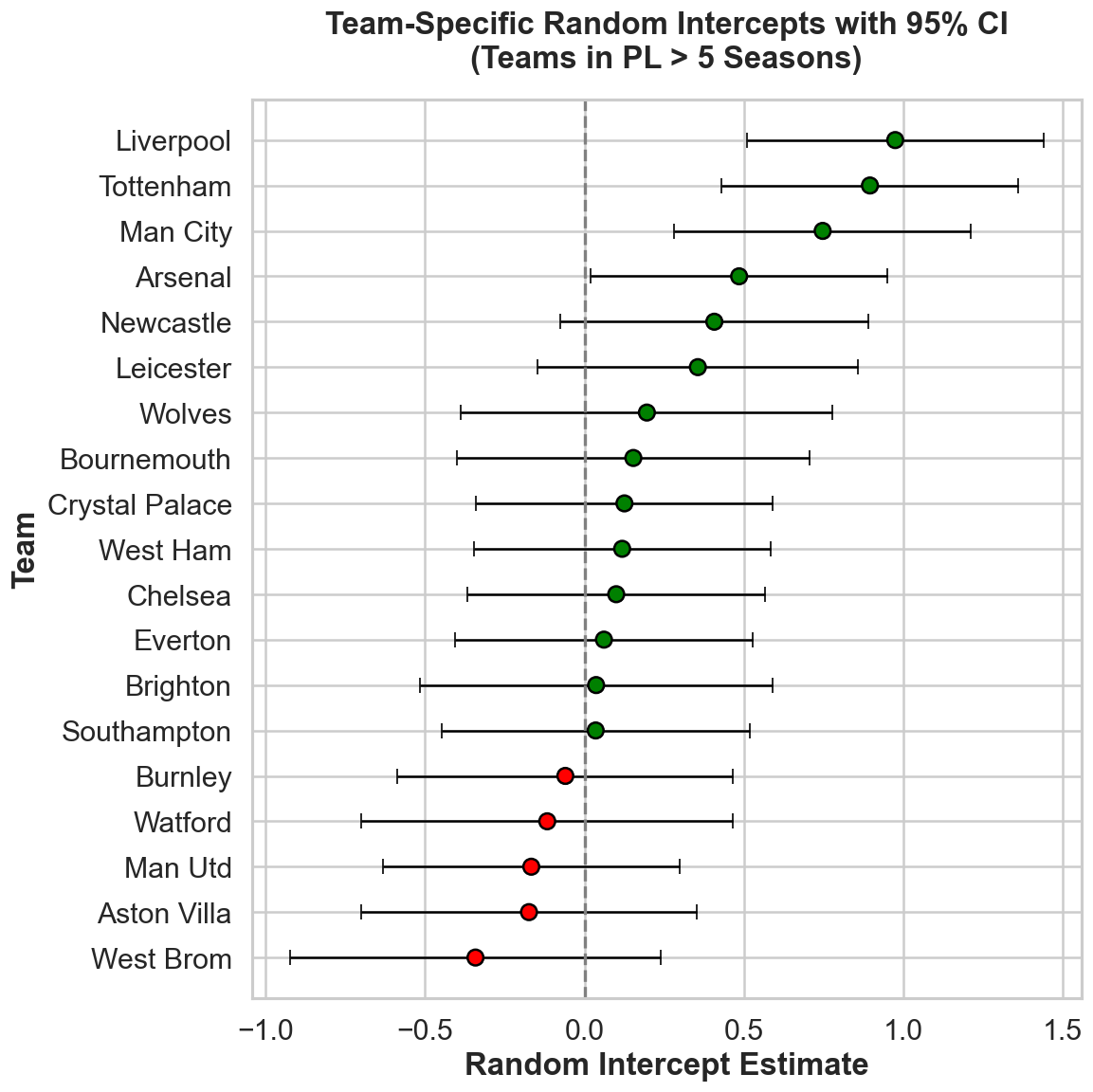
By fitting a mixed-effects model that accounts for the top 10 highest-paid players' wage per minute, their cumulative minutes played, and seasonal trends, we discovered that certain clubs have stable performance levels above or below what's expected based purely on financial and time resources. These persistent differences called random intercepts indicate that clubs like Liverpool and Tottenham consistently outperform expectations, whereas clubs such as West Brom and Aston Villa consistently fall short. The 95% confidence intervals around these estimates help us understand the certainty of each team's deviation from the league baseline.
Higher random intercept estimates likely capture stable, unmeasured advantages at certain clubs, potentially including better resource allocation, more effective recruitment strategies, or superior managerial practices. However, our data cannot conclusively identify exactly which of these factors are at play.
This modeling approach provides a major improvement over simpler regression analyses by explicitly quantifying persistent club-specific performance patterns that traditional models fail to reveal.
The Takeaways
This analysis demonstrates that while wage expenditure and minutes played are useful indicators of team success, their predictive power varies significantly between leagues. In the Premier League, there is a strong and consistent relationship between higher wage per minute, more playing time for top earners, and improved points accumulation supporting the notion that financial investment, when aligned with effective player utilization, yields competitive advantage. In contrast, the Championship presents a more volatile landscape: wage effects are weaker, and success is influenced by a broader mix of tactical, managerial, and structural factors. For clubs operating in either league, this study highlights the importance of not just spending, but spending wisely optimizing game time for top earners, benchmarking wage efficiency, and recognizing the diminishing returns of excessive outlay. Ultimately, it offers stakeholders a practical lens to evaluate whether they are truly getting "bang for their buck" from their wage bill.
Summary
- 💷 Wage Influence (Premier League):
In the Premier League, a 1% increase in wage-per-minute for top players corresponds to approximately a 0.34-point increase per season, illustrating significant but diminishing returns. - 📉 Wage Influence (Championship):
In the Championship, the correlation is weaker (~0.017 points per 1% wage increase), highlighting the diminished predictive power of spending in a highly competitive and tactically diverse environment. - ⏱️ Playing Time Efficiency:
Maximizing minutes for top earners remains a reliable strategy. Clubs must carefully manage the availability and on-field presence of their highest-paid players to fully capitalize on financial investments. - 📊 League-Specific Financial Dynamics:
Premier League wage bills vary significantly (~£30m to >£300m), making spending a strong predictor of outcomes, whereas the narrower wage distribution (£10–60m) in the Championship reduces spending’s predictive strength. - ✅ Club-Level Efficiency Matters:
The mixed-effects analysis demonstrates that stable club-specific factors captured by team random intercepts significantly affect performance beyond raw wage and minutes played. Teams consistently outperforming their spending highlight internal efficiencies or superior management practices. - 📈 Spend Wisely, Not Just More:
While increased financial investment generally correlates positively with success, clubs must focus equally on optimizing how they allocate these resources. Understanding club-level efficiency can guide smarter financial decisions, maximizing returns from every pound spent.